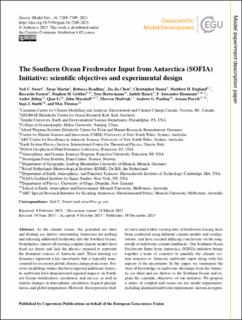| dc.description.abstract | As the climate warms, the grounded ice sheet and floating ice shelves surrounding Antarctica are melting and releasing additional freshwater into the Southern Ocean. Nonetheless, almost all existing coupled climate models have fixed ice sheets and lack the physics required to represent the dominant sources of Antarctic melt. These missing ice dynamics represent a key uncertainty that is typically unaccounted for in current global climate change projections. Previous modelling studies that have imposed additional Antarctic meltwater have demonstrated regional impacts on Southern Ocean stratification, circulation, and sea ice, as well as remote changes in atmospheric circulation, tropical precipitation, and global temperature. However, these previous studies have used widely varying rates of freshwater forcing, have been conducted using different climate models and configurations, and have reached differing conclusions on the magnitude of meltwater–climate feedbacks. The Southern Ocean Freshwater Input from Antarctica (SOFIA) initiative brings together a team of scientists to quantify the climate system response to Antarctic meltwater input along with key aspects of the uncertainty. In this paper, we summarize the state of knowledge on meltwater discharge from the Antarctic ice sheet and ice shelves to the Southern Ocean and explain the scientific objectives of our initiative. We propose a series of coupled and ocean–sea ice model experiments, including idealized meltwater experiments, historical experiments with observationally consistent meltwater input, and future scenarios driven by meltwater inputs derived from stand-alone ice sheet models. Through coordinating a multi-model ensemble of simulations using a common experimental design, open data archiving, and facilitating scientific collaboration, SOFIA aims to move the community toward better constraining our understanding of the climate system response to Antarctic melt. | en_US |

